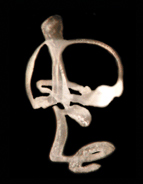Age-related decoupling of auditory nerve fibers from hair cells (cochlear synaptopathy) has been linked to temporal processing deficits and impaired speech recognition performance. The link between both is elusive. We have previously demonstrated that cochlear synaptopathy, if centrally compensated through enhanced input/output function (neural gain), can prevent age-dependent temporal discrimination loss. It was also found that central neural gain after acoustic trauma was linked to hippocampal long-term potentiation (LTP) and upregulation of brain-derived neurotrophic factor (BDNF). Using middle-aged and old BDNF-live-exon-visualization (BLEV) reporter mice we analyzed the specific recruitment of LTP and the activity-dependent usage of Bdnf exon-IV and -VI promoters relative to cochlear synaptopathy and central (temporal) processing. For both groups, specimens with higher or lower ability to centrally compensate diminished auditory nerve activity were found. Strikingly, low compensating mouse groups differed from high compensators by prolonged auditory nerve latency. Moreover, low compensators exhibited attenuated responses to amplitude-modulated tones, and a reduction of hippocampal LTP and Bdnf transcript levels in comparison to high compensators. These results suggest that latency of auditory nerve processing, recruitment of hippocampal LTP, and Bdnf transcription, are key factors for age-dependent auditory processing deficits, rather than cochlear synaptopathy or aging per se.
Abstract from: Age-Dependent Auditory Processing Deficits after Cochlear Synaptopathy Depend on Auditory Nerve Latency and the Ability of the Brain to Recruit LTP/BDNF. Marchetta P, Savitska D, Kübler A, Asola G, Manthey M, Möhrle D, Schimmang T, Rüttiger L, Knipper M, Singer W.
Brain Sci. 2020 Oct 6;10(10):710.
Other recent publications:
-
Deletion of BDNF in Pax2 Lineage-Derived Interneuron Precursors in the Hindbrain Hampers the Proportion of Excitation/Inhibition, Learning, and Behavior. Eckert P, Marchetta P, Manthey MK, Walter MH, Jovanovic S, Savitska D, Singer W, Jacob MH, Rüttiger L, Schimmang T, Milenkovic I, Pilz PKD, Knipper M.
Front Mol Neurosci. 2021 Mar 26;14:642679.
-
BDNF-Live-Exon-Visualization (BLEV) Allows Differential Detection of BDNF Transcripts in vitro and in vivo. Singer W, Manthey M, Panford-Walsh R, Matt L, Geisler HS, Passeri E, Baj G, Tongiorgi E, Leal G, Duarte CB, Salazar IL, Eckert P, Rohbock K, Hu J, Strotmann J, Ruth P, Zimmermann U, Rüttiger L, Ott T, Schimmang T, Knipper M.
Front Mol Neurosci. 2018 Sep 27;11:325.
-
Visualizing BDNF Transcript Usage During Sound-Induced Memory Linked Plasticity. Matt L, Eckert P, Panford-Walsh R, Geisler HS, Bausch AE, Manthey M, Müller NIC, Harasztosi C, Rohbock K, Ruth P, Friauf E, Ott T, Zimmermann U, Rüttiger L, Schimmang T, Knipper M, Singer W.
Front Mol Neurosci. 2018 Jul 31;11:260.
-
BDNF in Lower Brain Parts Modifies Auditory Fiber Activity to Gain Fidelity but Increases the Risk for Generation of Central Noise After Injury. Chumak T, Rüttiger L, Lee SC, Campanelli D, Zuccotti A, Singer W, Popelář J, Gutsche K, Geisler HS, Schraven SP, Jaumann M, Panford-Walsh R, Hu J, Schimmang T, Zimmermann U, Syka J, Knipper M.
Mol Neurobiol. 2016 Oct;53(8):5607-27. doi: 10.1007/s12035-015-9474-x. Epub 2015 Oct 17.
-
Is there a relationship between brain-derived neurotrophic factor for driving neuronal auditory circuits with onset of auditory function and the changes following cochlear injury or during aging? Schimmang T, Durán Alonso B, Zimmermann U, Knipper M.
Neuroscience. 2014 Dec 26;283:26-43. doi: 10.1016/j.neuroscience.2014.07.025. Epub 2014 Jul 24. Review.
-
L-type CaV1.2 deletion in the cochlea but not in the brainstem reduces noise vulnerability: implication for CaV1.2-mediated control of cochlear BDNF expression. Zuccotti A, Lee SC, Campanelli D, Singer W, Satheesh SV, Patriarchi T, Geisler HS, Köpschall I, Rohbock K, Nothwang HG, Hu J, Hell JW, Schimmang T, Rüttiger L, Knipper M.
Front Mol Neurosci. 2013 Aug 9;6:20. doi: 10.3389/fnmol.2013.00020. eCollection 2013.
-
Noise-induced inner hair cell ribbon loss disturbs central arc mobilization: a novel molecular paradigm for understanding tinnitus. Singer W, Zuccotti A, Jaumann M, Lee SC, Panford-Walsh R, Xiong H, Zimmermann U, Franz C, Geisler HS, Köpschall I, Rohbock K, Varakina K, Verpoorten S, Reinbothe T, Schimmang T, Rüttiger L, Knipper M.
Mol Neurobiol. 2013 Feb;47(1):261-79. doi: 10.1007/s12035-012-8372-8. Epub 2012 Nov 16.
-
Lack of brain-derived neurotrophic factor hampers inner hair cell synapse physiology, but protects against noise-induced hearing loss. Zuccotti A, Kuhn S, Johnson SL, Franz C, Singer W, Hecker D, Geisler HS, Köpschall I, Rohbock K, Gutsche K, Dlugaiczyk J, Schick B, Marcotti W, Rüttiger L, Schimmang T, Knipper M.
J Neurosci. 2012 Jun 20;32(25):8545-53. doi: 10.1523/JNEUROSCI.1247-12.2012.
|
